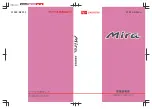
50
inside of the wheels, but if not, your tire dealer can
help you find out what they are. Never exceed the
maximum load or inflation pressure of your wheels.
Driving on under-inflated tires can cause the tires to
overheat, which leads to the breakdown of the tire’s
internal structure. Improper inflation also can reduce
your ability to control your vehicle. Tire blowouts
occur more during summer months than any other
time of the year. Properly inflated tires last longer, run
quieter, grip better, increase fuel mileage and safely
support and control your vehicle.
Check your tire pressure once a month and each
time before you take a trip with your tow vehicle and
trailer. Use a quality air pressure gauge to check the
pressure. Do not under-inflate or over-inflate your
tires. Inspect your tires for uneven or excessive wear.
Look for bulges, cuts, blisters on the sidewalls.
When you’re traveling, do as professional commer-
cial drivers do: inspect your tires regularly and check
and adjust cold inflation pressure every day that you
travel.
CAUTION
Individual wheel position weights must not
exceed the maximum tire load capacity.
Maximum tire load capacity can only be
achieved utilizing the maximum allowable psi
as listed on the sidewall of the tire.
ELECTRICAL CONNECTION TO TOW VEHICLE
Your Lance Trailer comes equipped with a 12-volt
electrical cord with a molded connector. If not already
installed, the tow vehicle electrical connector will be
installed by your Lance Trailer Dealer to your tow
vehicle wiring system. With the wiring and connec-
tors hooked-up, your tow vehicle will supply 12-volt
DC power to charge your trailer battery, operate the
trailer’s tail lights and running lights and engage the
trailer’s electric brakes.
To protect your tow vehicle’s 12-volt system from
overload, a circuit breaker should be installed at the
power source under the hood.
WEIGHING YOUR UNIT
Weigh the Tow Vehicle
The tow vehicle must be weighed with occupants and
full of fuel. Drive onto the scales and get the weight of
the total tow vehicle.
Next pull forward until the front axle is off the scale
and get the weight on the rear axle. Subtract the
weight on the rear axle from the total weight to get
the weight on the front axle.
Weigh the Trailer
With the trailer loaded and ready for a camp out-
ing, pull on the scales as before, disconnect the tow
vehicle and pull it off the scales to get the weight of
the trailer.
Reconnect the tow vehicle to the trailer and pull for-
ward until the tow vehicle’s rear axle is off the scales.
The weight will be the trailer axle weight.
Subtract the axle weight from the total trailer weight to
get the hitch weight.
Combined Weight of Tow Vehicle and Trailer
Pull onto the scales with both the tow vehicle and
trailer to get the combined weight of the total tow
vehicle and trailer.
Next pull forward until the front axle of the tow vehicle
is off the scale and get the weight on the rear axle of
the tow vehicle.
Subtract the weight on the rear axle from the total tow
vehicle and trailer weight to arrive at the weight on
the front axle.
Subtract the tow vehicle weights from the total tow
vehicle and trailer weight for each axle.
This amount should be less then the tow vehicle
manufacturer’s GAWR rating as shown on the Federal
Certification Label. If you are over the GAWR rat-
ing, you will need to remove or shift weight accord-
ingly. Once you are less then the GAWR, you need
to weigh each individual wheel to insure you are not
overweight from side to side.
Again pull on to the scales, but with only the right
front tire on the scales.
Pull forward and get the weight of the right rear tire.
Do the same for the left side tires. First the front and
then the rear.
Take the GAWR rating of the front axle and divide
by 2. Do the same for the rear. This is the GAWR for
each axle end. Now subtract the individual wheel
weights from the individual GAWR for each wheel.
If the amount is less, you are within the GAWR for
that axle end. If the amount is more, you are over the
GAWR for that axle end and you will need to adjust
how your unit is loaded to bring the weight down
within the GAWR.
Proper weight distribution, load management and
operating within established limitations will aid in safe
and enjoyable travel.
Summary of Contents for 1130
Page 6: ...6 This page intentionally left blank ...
Page 8: ...8 This page intentionally left blank ...
Page 10: ...10 This page intentionally left blank ...
Page 12: ...12 This page intentionally left blank ...
Page 22: ...22 This page intentionally left blank ...
Page 28: ...28 This page intentionally left blank ...
Page 34: ...34 This page intentionally left blank ...
Page 48: ...48 This page intentionally left blank ...
Page 54: ...54 This page intentionally left blank ...
Page 60: ...60 This page intentionally left blank ...
Page 68: ...68 This page intentionally left blank ...
Page 76: ...76 This page intentionally left blank ...
Page 86: ...86 This page intentionally left blank ...
Page 89: ......
Page 94: ...94 This page intentionally left blank ...
Page 113: ...113 SCHEMATICS ...
Page 120: ...120 ...
Page 121: ...121 ...
Page 123: ...123 ...
Page 131: ...131 ...
Page 132: ...132 ...
















































